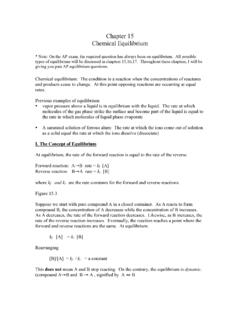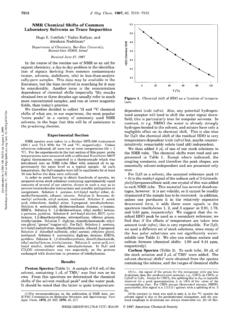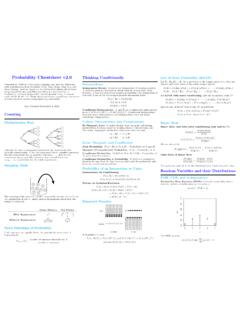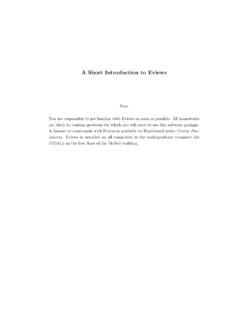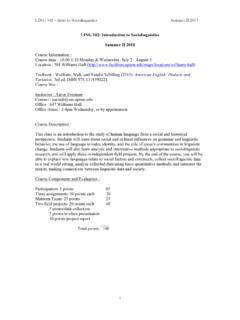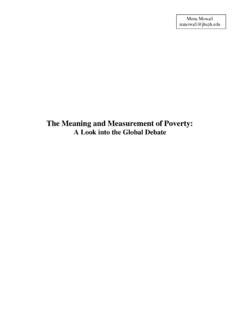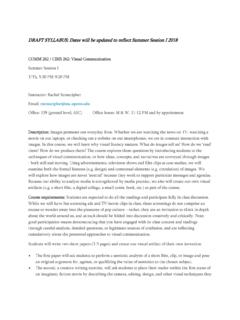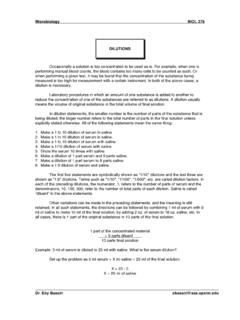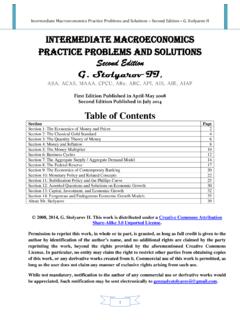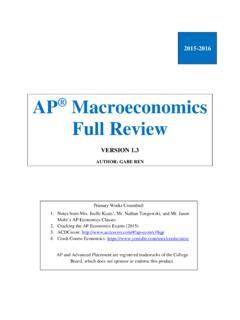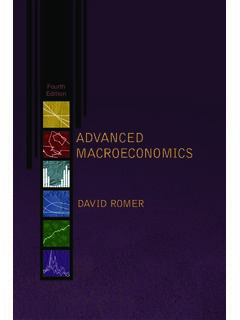Transcription of Macroeconomics: an Introduction
1 macroeconomics : an IntroductionJes us Fern andez-VillaverdeUniversity of Pennsylvania1 The Scope of macroeconomics Microeconomics: Object of interest is a single (or small number of)household orfirm. macroeconomics : Object of interest is the entire economy. We caremostly about:1. between Macro and Micro Micro and Macro are consistent applications of standard neoclassicaltheory. Unifying theme, EQUILIBRIUM APPROACH:1. Agents optimize given preferences and Agents actions are compatible with each other. This requires:1. Explicit about Models as are the Requirements of Theory?
2 Well articulated models with sharp predictions. Good theory cannot be vague: predictions must be falsifiable. Internal Consistency. Models as measurement should we care about macroeconomics ? Self Interest: macroeconomic aggregates affect our daily life. Cultural Literacy: understanding our world. Common Welfare: Essential for policymakers to do good policy. Civic Responsibility: Essential for us to understand our Brief Overview of the History of macroeconomics I Classics (Smith, Ricardo, Marx) did not have a sharp distinction be-tween micro and macro.
3 Beginning of the XX century: Wicksell, Pigou. Keynes, The General Theory of Employment, Interest, and Money(1936). 1945-1970, heyday ofNeoclassical Synthesis: Samuelson, Solow, Klein. Monetary versus Fiscal Policy: Friedman, Brief Overview of the History of macroeconomics II 1972, Rational Expectations Revolution: Lucas, Prescott, Sargent. 1982, Real Business Cycles: Kydland and Prescott. 1990 s, Rich dynamic equilibrium models. Future?7 Why do Macroeconomist Disagree? Most research macroeconomist agree on a wide set of issues.
4 There is wide agreement on growth theory. There is less agreement on business cycle theory. Normative issues. Are economist ideologically biased? Caplan (2002).8 National Income and Product AccountsJes us Fern andez-VillaverdeUniversity of Pennsylvania1A Guide to NIPA s What is the goal? When did it begin? Role of Simon Kuznets:1. Nobel Prize in Economics Prof. at Penn during the key years of NIPA creation. Gigantic intellectual achievement. Elaborated by Bureau of Economic Analysis and published in theSur-vey of Current : How are macroeconomic aggregates measured?
5 3 Gross Domestic Product (GDP)Canbemeasuredinthreedifferent, but equivalent ways:1. Production Expenditure Income GDP For 2003, nominal GDP was:$11,004,000,000,000 Population, July 2003 was:290,788,976 Nominal GDP per capita is roughly:$37,8425 Computing GDP through Production Calculate nominal GDP by adding value of production of all industries:production surveys. Problem of double-counting: USX and GM. Value Added=Revenue Intermediate Goods. Nominal GDP=Sum of Value Added of all GDP through ExpenditureC= ConsumptionI= (Gross Private) InvestmentG= Government PurchasesX=ExportsM=ImportsY=NominalGDPY C+I+G+(X M)7 Consumption (C) Durable Goods: 3 years rule.
6 Nondurable Goods. Private Investment (I) Nonresidential Fixed Investment. Residential Fixed Investment. Inventory Investment. Stocks vs. and the Capital Stock Capital Stock: total amount of physical capital in the economy Depreciation: the part of the capital stock that wears out during theperiod Capital Stock at end of this period=Capital Stock at end of lastperiod+Gross Investment in this period Depreciation in this period Net Investment=Gross Investment Depreciation=Capital Stock, endthis per. CapitalStock, Investment WhyincludedinGDP?
7 Inventory Investment=Stock of Inventories at end of this year Stockof Inventories at the end of last year Final Sales=Nominal GDP Inventory Investment11 Government Purchases (G) Sum of federal, state, and local purchases of goods and services. Certain government outlays do not belong to government spending:transfers (SS and Interest Payments). Government (E)andImports(M) Exports: deliveries of US goods and services to other countries. Imports: deliveries of goods and services from other countries to theUS. Trade Balance=Exports Imports Trade Deficit: if trade balance negative.
8 Trade Surplus: if trade balance positive13 Composition of GDP - Spendingin billion $in % of GDPT otal Nom. GDP11, , GoodsNondurable , , Private Investment1, in Inventory1, Purchases2, ,21, , , National Product11, GDP through IncomeNational Income: broadest measure of the total incomes of all AmericansGross Domestic Product (11, )+Factor Inc. from abroad ( ) Factor Inc. to abroad ( )= Gross National Product (11, ) Depreciation (1, )= Net National Product (9, ) Statistical Discrepancy ( )= National Income (9, )15 Distribution of National Income1.
9 Employees Compensation: wages, salaries, and fringe Proprietors Income: income of noncorporate Rental Income: income that landlords receive from renting, including imputed rent less expenses on the house, such as Corporate Profits: income of corporations after payments to theirworkers and Net interest: interests paid by domestic businesses plus interest earnedfrom and Capital Share Labor share: the fraction of national income that goes to labor income Capital share: the fraction of national income that goes to capitalincome.
10 Labor Share=Labor IncomeNational Income Capital Share=Capital IncomeNational Income Proprietor s Income?17 Distribution of National IncomeBillion $US% Income less Prod. , of Employees6, of National IncomeIndustriesVal. %National Income 9, , Forestry, , Trade569, , Insur., Real , , , of the Income Concepts: Personal Income Income that households and noncorporate businesses receiveNational Income (9, ) Corporate Profits ( ) Net Taxes on Production and Imports ( ) Net Interest ( ) Contributions for Social Insurance ( )+Personal Interest Income (1, )+Personal Current Transfer Receipts (1, )= Personal Income (9, )20 Other Income Concepts.
